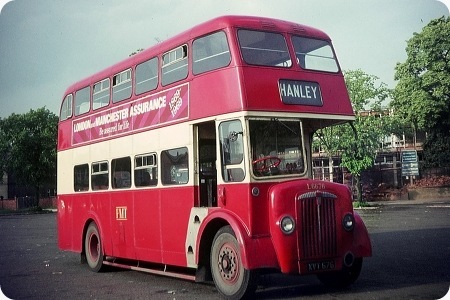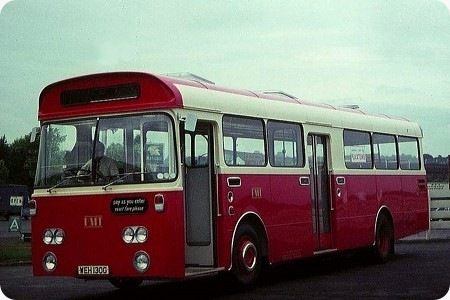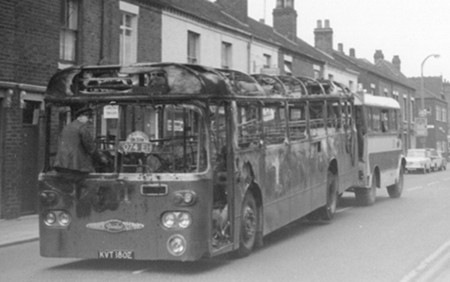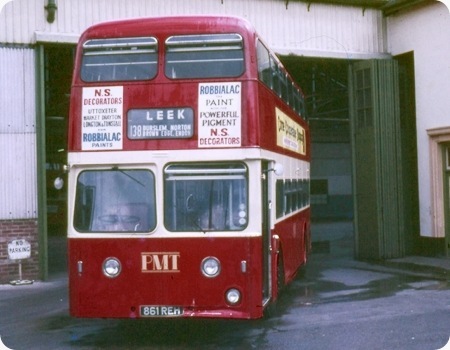PMT – Daimler CVG6 – XVT 676 – L6676
Potteries Motor Traction
1956
Daimler CVG6
Northern Counties L31/28RD
The above vehicle is one of a 30 strong batch delivered in 1956 – half with Metro Cammell H61RD bodies, the other half as shown.
These were delivered with Gardner 5LW engines and Twyflex Centrifugal Clutches (rather than the more usual fluid flywheels). Both features I suspect were down to the BET Group’s parsimony in relation to fuel consumption. The 5LW was never a match for the hilly Potteries area in these buses. Over the years, more than half were fitted with 6LW engines and one, H6656, even acquired a fluid flywheel as well. They were colloquially known as ‘Jumpers’ referring to their tendency to lurch when pulling away on an uphill gradient, something more common with the 5LW versions. Only three of the lowbridge variety kept 5LWs to the bitter end, L6664, L6666 and L6673. The photo was taken at Sandbach in May 1969 and shows Burslem (locally pronounced "Boslum") Depots L6676 on a Market Day extra from Hanley. Sandbach market was a popular attraction in the area in those days.
Photograph and Copy contributed by Ian Wild
A full list of Daimler codes can be seen here.
28/03/11 – 10:30
Apparently the Twiflex centrifugal clutch is still in production. To have lasted at least 54 years it must now be a judder-free product, though I know these things often depend on the installation. Fluid flywheels are reckoned to be only 96-97.5% efficient even at high revs/low load (where the engine itself isn’t particularly efficient) so I guess that allowing also for time spent in gear at traffic lights, with the engine on "heavy" idle churning the fluid round, the fuel consumption would be about 8% greater than that achieved with a clutch, whether plain or centrifugal. Two question, therefore:
1) Has anyone any comparative consumption figures?
2) Have any Twiflex-equipped buses survived?
Ian Thompson
25/01/13 – 18:10
There can’t have been many 27ft long lowbridge double deckers built with a top deck capacity of 31. It must have been achieved by an additional 4 seater row – I travelled on these quite frequently on the 46 to Blurton Estates but I don’t recall any particular problem with passing other seated passengers when alighting.
Ian Wild
26/01/13 – 06:38
Here’s a photo of a Twiflex Centrifugal Clutch, looking much like the shoe part of a drum brake, certainly simpler than a fluid flywheel. See //tinyurl.com
Chris Hebbron
27/01/13 – 07:55
That’s pretty much as I recall the Twiflex clutch except that the modern version seems to be hydraulically actuated (pipe to each segment). My recollection is that the shoe assemblies were on metalastic mounts which dampened the centrifugal force as the assembly was accelerated. It’s a long time ago-I may not have this quite right. interesting to see the design is now of Ukranian manufacture! I don’t recall having to replace one of these clutches whereas the fluid flywheel glands in Atlantean, Fleetline and Roadliner were commonplace failures.
Ian Wild
27/01/13 – 12:17
And to what vehicles do you recall these clutches being fitted, Ian?
Chris Hebbron
28/01/13 – 17:35
Chris-all 30 of the PMT Daimler CVG5s of 1956 were delivered with Twiflex clutches in place of fluid flywheels. I’m sure I’ve read somewhere (maybe elsewhere on this site?) that Walsall Corporation also tried them in the mid 50s.
Ian Wild
22/07/14 – 06:48
Walsall Corporation took delivery of 15 Daimler CVG6 buses with twiflex system transmission in 1956 and they were nicknamed "jumping jacks". Here’s a newspaper report from 1974 referring to these buses: www.flickr.com/photos/walsall1955/
Walsall1955
09/12/15 – 06:09
At Stoke Depot we did meal break duties on these on the 46 Blurton run. These ‘Jumping Jacks’ were hated to a man.
David Knight
Quick links to the - Comments Page - Contact Page - Home Page




